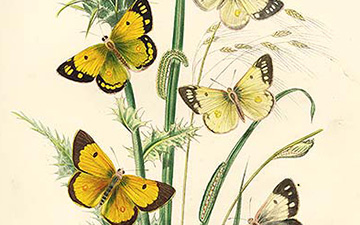Colias is a genus of butterflies in the family Pieridae. They are usually called clouded yellows; the North Americanname “sulphurs” is elsewhere used for Coliadinae in general. The closest living relative is the genus Zerene,[4] which is sometimes included in Colias.
Most if not all species of this genus, as usual for Coliadinae, do not sequester toxins or other noxious compounds from their food plants. They are therefore a well-loved prey item of insectivores as compared to Pieris of the related Pierinae. They make up this disadvantage by being more nimble and better able to evade attacks by would-be predators.[7]
Notable lepidopterologists who did many studies on this genus included Julius Röber, J. Malcolm Fawcett, George B. Johnson, and Henry Rowland-Brown.
Hybridization runs rampant in these polytypic and clinal[8] butterflies, confounding molecular phylogenetics studies. In general, cladistic analyses of only one type of data (particularly mtDNA sequences) cannot be considered reliable. Regardless, the evolutionary distance within some “species” is so large that cryptic speciation rather than (or in addition to) interbreeding seems to be the cause. For example, the Beringian populations traditionally assigned to the Northern Clouded Yellow (C. hecla) could warrant recognition as a species; hybridization between North American and Asian populations seems to have played a role in their evolution, but as a whole they appear to be a rather old and distinct lineage.[9]
(From Wikipedia, October 2013)



